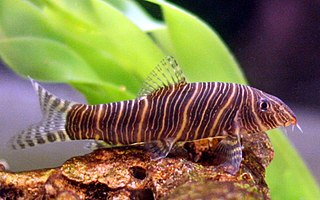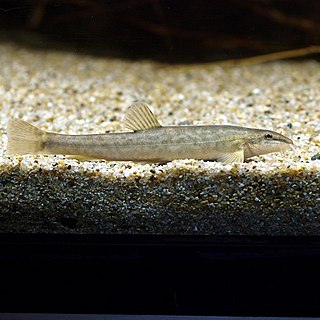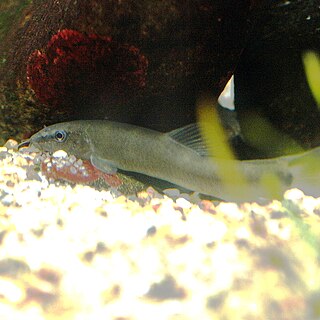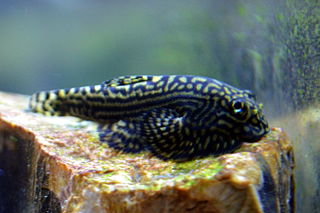
Cypriniformes is an order of ray-finned fish, which includes many families and genera of cyprinid fish, such as barbs, gobies, loaches, botias, and minnows. Cypriniformes is an "order-within-an-order", placed under the superorder Ostariophysi—which is also made up of cyprinid, ostariophysin fishes. The order contains 11–12 families, over 400 genera, and more than 4,250 named species; new species are regularly described, and new genera are recognized frequently. Cyprinids are most diverse in South and Southeast Asia, but are entirely absent from Australia and South America. At 112 years old, the longest-lived cypriniform fish documented is the bigmouth buffalo.

Cobitidae, also known as the true loaches, is a family of Old World freshwater fish. They occur throughout Eurasia and in Morocco, and inhabit riverine ecosystems. Today, most "loaches" are placed in other families. The family includes about 260 described species. New species are being described regularly.

Balitoridae, the hillstream loaches or river loaches, is a family, of small fish from South, Southeast and East Asia. The family includes about 202 species. They are sometimes sold as "lizardfish" or "flossensaugers". Many of the species are popular for aquaria, species in the genus Sewellia are most commonly sold in the aquaria trade. They have a number of similarities with the Cobitidae, their sibling family of "loaches", such as multiple barbels around the mouth. They should not be confused with the loricariids, which look similar but are a family of catfish.

The clown loach, or tiger botia, is a tropical freshwater fish belonging to the botiid loach family. It is the sole member of the genus Chromobotia. It originates in inland waters in Indonesia on the islands of Sumatra and Borneo. In Sentarum, West Borneo that fish named: ulanguli. It is a popular fish in the freshwater aquarium trade and is sold worldwide.

Botia is a genus of freshwater fish in the loach family (Botiidae). It was a large genus with about 20 species. In 2004 Maurice Kottelat proposed in his paper to divide the genus into four related genera based on fish appearance and locality:

The pond loach, also known as the Dojo loach, oriental weatherloach or oriental weatherfish, is a freshwater fish in the loach family Cobitidae. They are native to East Asia, but are also popular as an aquarium fish and introduced elsewhere in Asia and to Europe, America and Australia. The alternate name weather loach is shared with several other Cobitidae, including the other members of the genus Misgurnus and the spotted weather loach. This term comes from their ability to detect changes in barometric pressure before a storm and react with frantic swimming or standing on end.

Yasuhikotakia is a genus of botiid loaches, many which are popular aquarium fish. It is named in honor of Japanese collector/researcher Dr. Yasuhiko Taki. This genus has been separated from the genus Botia in the paper by Maurice Kottelat in 2004.

Barbatula is a genus of fish in the family Nemacheilidae native to Europe and Asia. They are found in streams, rivers and lakes, and the genus also includes Europe's only cavefish, which only was discovered in the Danube–Aachtopf system in Germany in 2015.

Cobitis is a genus of small freshwater fish in the family Cobitidae from temperate and subtropical Eurasia. It contains the "typical spiny loaches", including the well-known spined loach of Europe. Similar spiny loaches, occurring generally south of the range of Cobitis, are nowadays separated in Sabanejewia.

The ayumodoki or kissing loach is a species of ray-finned fish in the family Botiidae. It is found in lakes and streams on Honshu, the largest island in Japan. Spawning grounds for kissing loach are ditches and small reservoirs for rice cultivation of a river system located in Japan. The kissing loach migrates to flooded areas, including paddy field areas, for spawning in early summer and the spawning of this species is limited after the formation of flooded areas over terrestrial vegetation. These flooded areas are the result of water from mountain streams and irrigation ponds flooding once dry land and creating man-made wetlands. As adults, Parabotia curtus migrate from these flooded paddy fields to fast moving, muddy streams and rivers like the Yodo River.

The stone loach is a European species of fresh water ray-finned fish in the family Nemacheilidae. It is one of nineteen species in the genus Barbatula. Stone loaches live amongst the gravel and stones of fast flowing water where they can search for food. The most distinctive feature of this small fish is the presence of barbels around the bottom jaw, which they use to detect their invertebrate prey. The body is a mixture of brown, green and yellow.
Nun galilaeus, also known as the Galilean stone loach, is a species of stone loach in the family Nemacheilidae native to Israel and Syria.
The true Kuhli loach, which can be used synonymously with "coolie" loach, occasionally referred to as eel loach, is a small eel-like freshwater fish belonging to the loach family (Cobitidae). They originate from the island of Java in Indonesia. This serpentine, worm-shaped creature is very slender and nocturnal. Its distinctive orange-pink coloration with triangular black stripes and long lifespan makes it a popular aquarium species.

Loaches are ray-finned fish of the suborder Cobitoidei. They are freshwater, benthic (bottom-dwelling) fish found in rivers and creeks throughout Eurasia and northern Africa. Loaches are among the most diverse groups of fish; the 1249 known species of Cobitoidei comprise about 107 genera divided among 9 families.

The Gobionellinae are a subfamily of fish which was formerly classified in the family Gobiidae, the gobies, but the 5th Edition of Fishes of the World classifies the subfamily as part of the family Oxudercidae. Members of Gobionellinae mostly inhabit estuarine and freshwater habitats; the main exception is the genus Gnatholepis, which live with corals in marine environments. The subfamily is distributed in tropical and temperate regions around the world with the exception of the northeastern Atlantic Ocean, the Mediterranean Sea, and the Ponto-Caspian region. It includes around 370 species and 55 genera: Wikipedia articles about genera list about 389 species.

Pseudogastromyzon is a genus of ray-finned fish belonging to the family Gastromyzontidae, commonly called the hillstream loaches, although this also refers to the loaches in the family Balitoridae. The loaches in this genus are found in fast-flowing streams and rivers in China.

Sewellia is a genus of fish in the family Gastromyzontidae. They are commonly called hillstream loaches and are found in Laos and Vietnam. According to Roberts (1998) a possible defining characteristic of the genus Sewellia is their posterior pelvic valve is highly complex and different from other rheophilic loaches, their posterior pelvic valve involves the overlapping of the second to last ventrally exposed rays. Adapted to high velocity streams, Sewellia have depressed body shapes that are laterally expanded, thus increasing their hydrodynamical properties and allowing them to better stay attached to rocks in swift current. Sewellia also have paired fins with a single simple ray and numerous branched rays allowing them to grip rocks in swift current.
Yaoshina is a monospecific genus of freshwater ray-finned fish belonging to the family Gastromyzontidae, commonly called the hillstream loaches, although this also refers to the loaches in the family Balitoridae. The only species in the genus is Yaoshania pachychilus, the panda loach. A loach which is endemic to mountain streams in Jinxiu County, Guangxi in China. This species grows to a length of 5.8 centimetres (2.3 in) SL. This species is monotypic, but it was formerly included in Protomyzon. Juveniles are strikingly coloured in black-and-white, but adults are relatively plain. Y. pachychilus quickly became a popular aquarium fish in the 2010s.
Ghatsa is a genus of ray-finned fish in the family Balitoridae. This genus is created for species previously assigned to Homaloptera from the Western Ghats of India.
Schistura madhavai, is a species of ray-finned fish in the genus Schistura, newly distributed from Sri Lanka. It is the second species of Schistura stone loach described from Sri Lanka, the other being the widely distributed native species Schistura notostigma.















